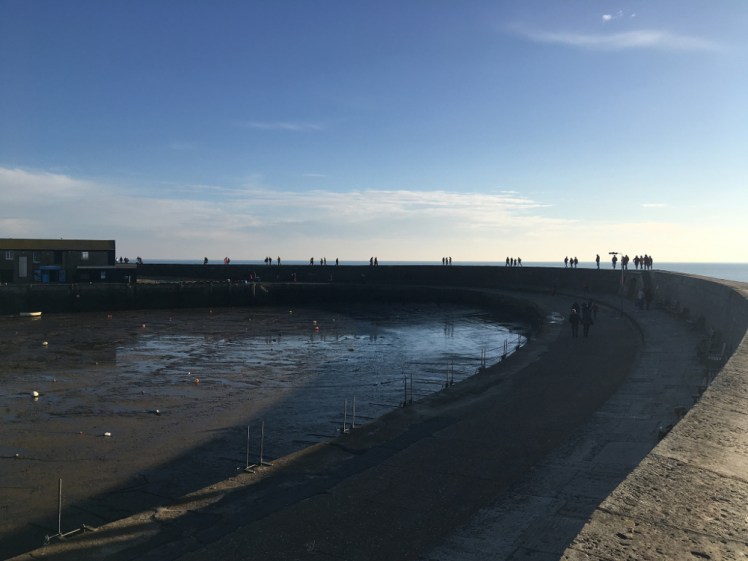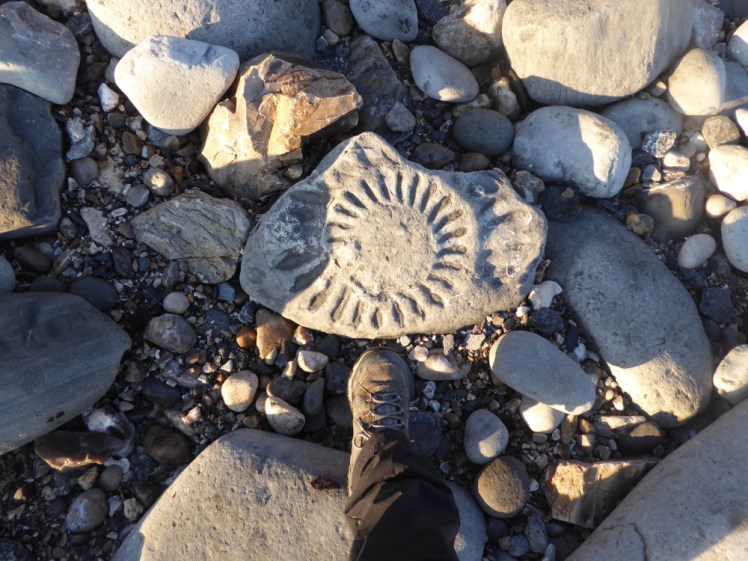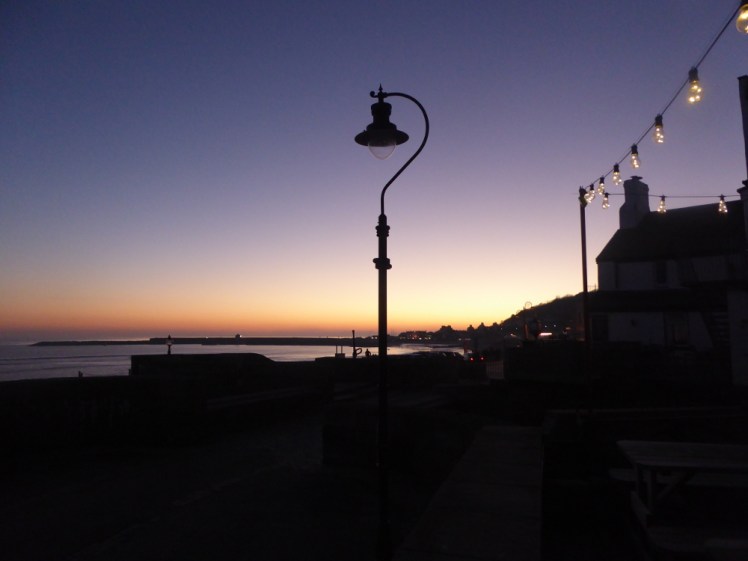Welcome to 2019 and welcome to the latest edition of my annual Two Bears Adventure series.
This is Tom (also known as Tom Bear and, well, I am a polar bear, hence two bears). You may remember him from Two Bears in Swanage, Two Bears in Charmouth or Two Bears in Edinburgh.

This year we went to Lyme Regis. Yes, it’s out in the sticks but for this part of the country, it’s a bustling metropolis. It has bars and cafes, sea and sand, rocks and fossils. Just what two bears look for in a Christmas adventure. I wasn’t sure we’d make it to Lyme Regis; long before Bridport, my car started making a high-pitched squealing noise and I know it could do with a new belt of some kind. I decided I’d check the oil at Bridport – I don’t know much about cars but I can do that much – but by Bridport it had stopped and didn’t come back until we were climbing the hill out of Lyme Regis at the end of the day.
But we made it. Tom is a weather lucky charm – we always have good weather for our Christmas adventure. Today it was a little bit chilly but certainly not hat and gloves weather. Not even coat weather. Blue sky and sunshine. It took longer to get there than it should do lunch was the first stop. We found a teeny-tiny cafe at the bottom of the main road. Its insides are made from planks reclaimed from ships and it was crazy busy. A table for two was one thing but people kept turning up asking for “Table for seven?” “Umm.. five adults and a child?” and somehow they fitted them in. Tom had fish & chips, pronounced “not bad at all” and I had a cheese toastie, nice and crispy, neither burnt not limp – a lot of food places can’t quite manage an actual edible toastie but this one managed.
We had a quick trip through town. Lyme Regis is very good at fish, fudge and fossils. Well, it’s got strong fossil heritage. Apart from those cliffs, which have yielded multiple complete ichthyosaur and pterosaur skeletons over the years, this was the home of Mary Anning, palaeontologist and fossil pioneer refused admission to the Geological Society of London for the crime of being a woman in the 1820s and 30s.
We dogspotted all along the beach and then walked along the Cobb, the famous harbour wall that stars in The French Lieutenant’s Woman. There’s been a Cobb of some kind here since at least 1328, although the current one only dates back to 1820. Tom wanted to walk on it and I always want to walk on it – on the high top, not the inner walkway that was actually meant for walking. That said, if you weren’t meant to walk on the top, why are there so many steps up to it?

So we walked. The Cobb tilts quite a lot, leaning towards the sea side, where it falls straight down into relatively deep water that hides some very nasty rocks. If you fell off the Cobb, I’m not sure you’d swim away. It was low tide so the harbour inside the wall was absolutely empty, just a lot of small boats perched in or on the mud. The lifeboat launches from the landward end of the harbour. I can only assume no one requires the RNLI at low tide.

And then we headed into the fossil beach. Lyme Regis is a great place for fossils. The first part of the beach is stony, not really suitable for soft non-waterproof shoes. Further out, limestone shelves appear off the beach, fossils start appearing in boulders and very crumbly cliffs start to loom. I keep my distance from crumbly cliffs. They collapse pretty regularly. On the bright side, these cliffs contain untold fossils and every collapse could expose a brand new perfect pristine complete skeleton. This is where Mary Anning found hers, although she deliberately came here in bad weather looking for landslides and definitely had at least one very near miss. The cliffs are Blue Lias, a mix of limestone and shale (Tom, I was half right about the oil. You can get shale oil from shale but it’s more expensive and more environmentally damaging to extract than normal oil which is probably why they don’t do it here. It’s what the nodding donkeys produce at Kimmeridge). There are always people, and kids, digging around in the loose rock with their fossil hammers, cheerfully oblivious to the possibility of more cliff falling, this time directly onto them.

You can take home any fossils you find here, although I’d report any major find – like a complete ichthyosaur skeletons – to one of the local experts, eg one of the big fossil shops or the museum. If you leave it there, it’ll get washed away in the next storm or even high tide or get buried by the next cliff collapse. Of course, there are plenty of beautiful and perfect fossils in boulders bigger than the tyres on my car, mostly ammonites, which appear in such huge numbers on this beach that no one really cares about one more or less unless they’re actual perfect preserved samples that can be sold.

The other thing that exists on the beach here is a shelf covered in dinosaur footprints but could I find it? Maybe it’s all weathered away from being exposed. Maybe we’ve worn it away by walking on it. Maybe it’s underneath the layers of squelchy low-tide mud. Maybe I just didn’t go far enough. It was squelchy. I sank over the top of my boots two or three times and anyway, I was mostly scrambling on the boulders looking for big heavy exposed ammonites.

With the fossil-hunting over, we drink-hunted our way back to the car. Mulled wine in a pub on the seafront, sitting outside at the high bar table, where we could see sunset turning the eastern cliffs pink and red. People passing in winter coats and hats. People passing in wetsuits carrying surfboards and looking frozen. Kids passing in shorts and bare feet, eating ice cream. If you’d just stepped out of a time machine, I don’t know if it would be very obvious this was midwinter.

Finally, a glass of wine on the new – newish – sea defences, right next to the museum, former home and fossil shop of one Mary Anning. She was well known around Europe; that shop had some high profile customers. As well as lords of manors, the lanowner of Sandringham and assorted geologists, palaeontologists and fossil experts from all over Europe and America, King Frederick Augustus II of Saxony bought fossilised skeletons from here. Of course, a lot of them wrote academic papers on their discoveries with no mention of the person who actually discovered them. And we were basically in her back garden.


From here we could see more cliff and less beach. Oh, and solar-powered fairy lights overhead which made alien noises, like a flying saucer powering up, every few minutes.

Instead of walking back through town, we followed the new path along the bottom of the cliff, along the new defences. Charmouth, where we went last year, looked so close but if you’re going to walk there – which you can – you have to be very careful with the tide and bear in mind that stretch of cliff has had some horrifying collapses. Probably better to take the inland route via the golf club.
And other than a long drive home and an impromptu lecture on nuclear physics, that was our day done. We’ve started throwing around ideas for next year. Glastonbury? Golden Cap? We’ll see.
Like it? Pin it!
